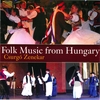

Playlist: Folk Music and the Revival in Hungary (Introduction to World Music: Europe) by Jenna Makowski, Alexander Street Press
Hungarian folk music and dance have been at the forefont of Hungarian national identity since the turn of the century, when classical composers like Bartok and Kodaly spent months in the rural countryside, recording and documenting folk songs, which had various functions from accompanying daily chores to weddings. Hungarian identity, and thus Hungarian music, has a complex history, where nationalism, ethnicity and Roma identity all come into play. There was a revival of Hungarian music and dance beginning in the 1970s, when urban dance houses became a center of socialization for young folks, and they continue today.
Format
Artwork
Title
Notes
Duration / Pages
Date added
Come on Girls, To the Spinning House
produced by Béla Bartók, 1881-1945 and Henry Cowell, 1897-1965; in Folk Music of Hungary (Folkways Records, 1950), 1 min
Some of the earliest recordings of Hungarian folk music were gathered in the first decades of the 20th centuries by composers such as Bela Bartok and Zoltan Kodaly, who spent years traveling through Hungary's countryside and recording songs in the field. According to Bartok's notes, this song is "A hearty-voiced woman singing in a style which reminds one forcibly of Gaelic-speaking singers of Ireland and Scotland. This style is an old traditional one, in Dorian form on B flat." (Folk Music of Hungary. Liner Notes. Folkways Records, 1950.)
01:16
26 Dec 2013
Recorded in 1957, this old folk song and the album on which it was released came out one year after the Hungarian Revolution was crushed by the Soviet Union. Folk songs played a large role in the creation of a Hungarian national identity during the decades of Soviet control of Hungary. (Folk Songs of Hungary. Liner Notes. Folkways Records, 1957.)
01:35
26 Dec 2013
Bonchidai Ritka Magyar
produced by Pablo Cárcamo, 1951-; performed by Kálman Balogh, Beáta Salamon, István Berán, Zsolt Nagy and Albert Mohácsy; in Kálmán Balogh: The Art Of The Gipsy Cimbalom (ARC Music Productions, 2006), 2 mins
The ancestor of the cimbalom appears to be the Indian santur. It was probably brought to Europe by gypsies. In Hungary it was first mentioned in the 15th century but as a smaller version of the instrument we know today. The cimbalom became so popular that is was played in religious services in churches as well as inns. Today, it is a central instrument in Hungarian music. (Kalman Balogh: The Art of the Gipsy Cimbalom. Liner Notes. American Record Corporation, 2006.)
02:18
26 Dec 2013
In Memory of Balogh Elemér
produced by Pablo Cárcamo, 1951-; performed by Kálman Balogh, Beáta Salamon, István Berán, Zsolt Nagy and Albert Mohácsy; in Kálmán Balogh: The Art Of The Gipsy Cimbalom (ARC Music Productions, 2006), 3 mins
This song is a tribute to Balogh Elemer, considered one of the greatest cimbalom players. It is performed by his nephew, Kalman Balogh. (Kalman Balogh: The Art of the Gipsy Cimbalom. Liner Notes. American Record Corporation, 2006.)
03:20
26 Dec 2013
Czadas, or Csardas, is a traditional folk dance dating from the 18th century. It has morphed into various forms, including into classical compositions by composers like Liszst and Brahms, as well as into traditional dance repertoires in the contemporary tanchaz dance movements in Budapest today. Listen for tempo variations, a main characteristic of the genre. (The Music of Hungary. Vanilla OMP, 2009.)
03:10
26 Dec 2013
Kalotaszegi magyaroké: Legényes, csárdás és szapora
produced by Guy Tourville, fl. 1999; performed by Krisztián Siklósi, fl. 2008, Miklós Vén, Huba Ákos Szüts, fl. 2008, Balázs Barta, fl. 2008, Adrienn Nesz, fl. 2008, Zsuzsanna Grósz, 1985- and Boglárka Szily, fl. 2008, Csurgó Zenekar; in Csurgó Zenekar: Folk Music from Hungary (ARC Music Productions, 2008), 6 mins
A movement to bring folk dances into urban Hungarian cities began in the 1970s, alongside a revival of folk music and dance. The tanchaz, or dance house movement, is alive and well today. The piece performed here is by a tanchaz group, who play live music music to accompany folk dances at dance clubs in Budapest. This particular piece comes from a region of Transylvania. It includes a csardas. (Csugo Zenekar: Folk Music from Hungary. Liner Notes. American Record Corporation, 2008.)
06:14
26 Dec 2013
Pusztinai nagy hegy alatt
produced by Guy Tourville, fl. 1999; performed by Krisztián Siklósi, fl. 2008, Miklós Vén, Huba Ákos Szüts, fl. 2008, Balázs Barta, fl. 2008, Adrienn Nesz, fl. 2008, Zsuzsanna Grósz, 1985- and Boglárka Szily, fl. 2008, Csurgó Zenekar; in Csurgó Zenekar: Folk Music from Hungary (ARC Music Productions, 2008), 7 mins
Moldva is that part of Hungary which lies to the east of Transylvania in today's Romania. The Hungarians there are a very isolated minority. Due to this, folk music and dance have been preserved in there in a very archaic form. The group presents them as close to their original forms here as possible. (Csugo Zenekar: Folk Music from Hungary. Liner Notes. American Record Corporation, 2008.)
07:04
26 Dec 2013
Delete playlist item?





